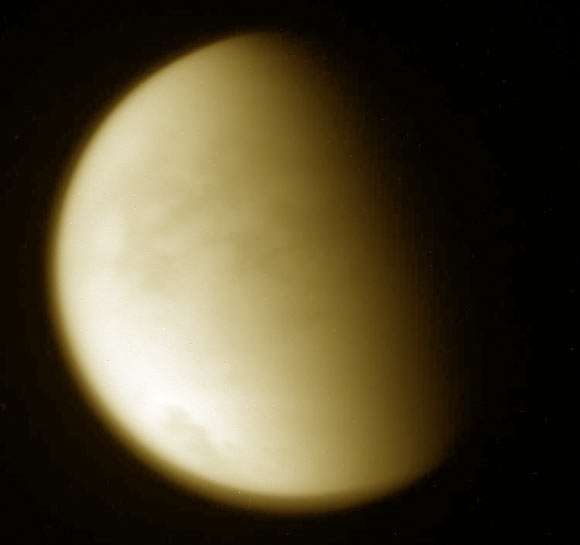On April 22, 2017, NASA’s Cassini spacecraft made its 127th and final close approach to Titan, passing at an altitude of about 608 miles (979 km) above the moon’s surface.

This image of Titan (colorized) was captured by Cassini during its final close flyby of the hazy moon on April 21, 2017. Image credit: NASA / JPL-Caltech / Space Science Institute.
“Cassini’s up-close exploration of Titan is now behind us, but the rich volume of data the spacecraft has collected will fuel scientific study for decades to come,” said Cassini project scientist Dr. Linda Spilker, of NASA’s Jet Propulsion Laboratory.
This flyby is the gateway to Cassini’s Grand Finale: as the spacecraft passed over Titan, the moon’s gravity bent its path, reshaping the probe’s orbit slightly so that instead of passing just outside Saturn’s main rings, Cassini will begin a series of 22 dives between the rings and the planet on April 26.
“With this flyby we’re committed to the Grand Finale,” said Cassini project manager Dr. Earl Maize, also from NASA’s Jet Propulsion Laboratory.
“The spacecraft is now on a ballistic path, so that even if we were to forgo future small course adjustments using thrusters, we would still enter Saturn’s atmosphere on September 15 no matter what.”
Cassini received a large increase in velocity of 1,925 mph (860.5 m/sec) with respect to Saturn from the close encounter with Titan.
After buzzing Titan, the probe coasted onward, reaching the farthest point in its orbital path around Saturn at 11:46 p.m. EDT (8:46 p.m. PDT) on April 22. This point, called apoapse, is where each new Cassini lap around Saturn begins.
Technically, Cassini began its Grand Finale orbits at this time, but since the excitement of the finale begins in earnest on April 26 with the first ultra-close dive past Saturn, the mission is celebrating the latter milestone as the formal beginning of the finale.
Cassini’s first finale dive will take place on April 26 at 5 a.m. EDT (2 a.m. PDT).
The spacecraft will be out of contact during the dive and for about a day afterward while it makes science observations from close to the planet.
The earliest time Cassini is scheduled to make radio contact with Earth is 3:05 a.m. EDT (12:05 a.m. PDT) on April 27.
Images and other data are expected to begin flowing in shortly after communication is established.







